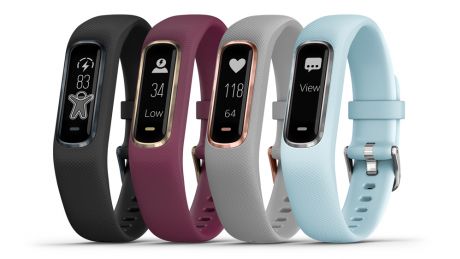You can trust Coach
Are you running on empty or charged up and ready to go? The new Garmin Vivosmart 4 says it can tell you, thanks to one of its new flagship features. The Body Battery rating promises to open a window on to your energy levels throughout the day, using information on the quality of your sleep, your heart rate variability and past activities.
It sounds like an excellent idea and one that’s very easy to understand. Although you may think you naturally know your energy levels already, we can imagine using the score to decide whether we’re too physically tired for a training session or just too lazy.
Along with this new feature, the sleep tracking on the Vivosmart 4 has seen a serious upgrade in terms of both hardware and software. A pulse ox sensor has been added, a type of sensor that’s previously only been present on Garmin’s flagship GPS device, the Fenix 5X Plus (£750), where it’s used to check the acclimatisation of the body to high altitudes. On the Vivosmart 4 it informs the Pulse Ox Sleep Tracking feature which will provide a measure of the oxygen level in your blood – an SpO2 rating – but this time it will be used to tell you about the quality of your sleep. While we haven’t had a chance to try this feature yet, we know Fitbit will soon start testing a similar sensor in its Charge 3, Versa and Ionic devices to identify conditions like sleep apnoea where people stop breathing for a period during sleep.
See related
Garmin has also improved the rest of its sleep tracking offering with estimates on the duration of light, deep and REM sleep. We’re keen to try these new features in person because sleep tracking is an area where Garmin has fallen behind the competition – we’ve worn Garmins that log the start of a night’s sleep when we were simply sitting still watching a movie. Sorting this part of its offering out could make it a serious competitor to Fitbit’s activity bands.
Both the Body Battery and Pulse Ox Sleep Tracking features are currently available only on the new Vivosmart 4, though with Garmin you can usually expect them to make their way on to other devices fairly quickly. In addition to these updates, the Vivosmart 4 improves its battery life from five to seven days.
Looks-wise the Vivosmart has seen some refinements too. Firstly, it’s a little slimmer than its predecessor. Previously the bottom of the screen blended into the strap, which we thought looked slick, but in place of this now is a metallic rectangular border, which we’re withholding judgement on until we see it in person. The Vivosmart 4 is also available in five colourways, where the previous model came in black only. The bands aren’t interchangeable, though, so choose carefully – you’re stuck with your choice.
The Vivosmart 4 adds these features to an already impressive all-round package, with 24/7 heart rate monitoring, everyday activity and sports tracking, VO2 max measurement and some smart notifications. It costs £119.99, which is £10 cheaper than the Fitbit Charge 3, though it’s worth noting that the Vivosmart 4 has no GPS and won’t connect to your phone for assisted GPS like the Charge does.
Buy from Garmin (available soon) | £119.99

Nick Harris-Fry is a journalist who has been covering health and fitness since 2015. Nick is an avid runner, covering 70-110km a week, which gives him ample opportunity to test a wide range of running shoes and running gear. He is also the chief tester for fitness trackers and running watches, treadmills and exercise bikes, and workout headphones.

